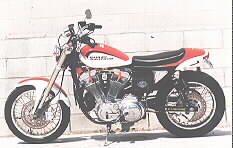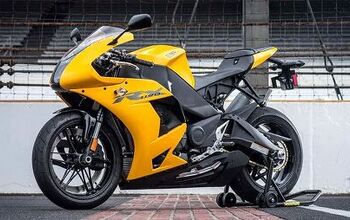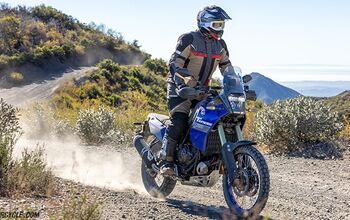Bartels' XLR 1200
Not many things have stayed the course of American racing for twenty five years - but one of the most successful will soon rack up a quarter century of race wins. That most traditional, most successful racer is the alloy-engined Harley-Davidson XR 750.
The history of the winningest motorcycle in AMA history goes much further back than 1972, really it goes back to the days in the 1930s when the AMA decided to ban factory race specials, and keep the racetracks open to stock-type motorcycles. That's how 750cc Class C racing was born, and from the start, Harley 750cc V-twins raced in it. The XR750, which debuted at the start of the seventies, was just another in a long line of winning Milwaukee dirt trackers.
Only difference, it was matched against BSA, Triumph and Yamaha instead of Indian.
After all those years, and as makers of the winningest motorcycle around, you'd think Harley would market a replica model. Well, you'd think that. They even tried, back in the early eighties, with the XR 1000, a Sportster-based street bike with twin Dellorto carburetors and reversed, reworked rear cylinder head.
That most traditional, most successful racer is the alloy-engined Harley-Davidson XR 750.
And in fact, hundreds remained in the warehouse for months, until word started going around about how well they responded to just a little bit of tuning. With a lot of extra work, they turned into 90 hp monster bikes. Suddenly, they were gone from the showrooms: but then they were gone from the catalog too, and Harley-Davidson has never again sold an XR lookalike. More's the pity, according to many enthusiasts.
Someone didn't forget the XR heritage at Bartels' Harley-Davidson, of Marina del Rey, California.
Bartels' has sponsored dirt track racers for years, including heroes like Jay Springsteen. What could be more natural than to create a bike like the one you'll see on the track - but with street manners. The XLR you see here is a Bartels' hybrid, using an Evolution Sportster five speed in a twin shock dirt track racing frame, complete with racer style.
Though it looks like a Sportster engine at a distance, the XR is a very different animal.
There have been XR conversions for the street - but the problem with the XR 750 (and no doubt one of the reasons H-DIt's kind of hard to stop yourself from sticking your leg down on turns, because the bike feels like it wants you to just gas it and slide round. didn't try too hard to replicate this model) is that it remains a hand-built motorcycle. Though it looks like a Sportster engine at a distance, the XR is a very different animal. Inside the cases, bearings, crank, ignition and top end are all very different from the XL series. So different, in fact, that it takes a competent mechanic indeed to set up an XR. Each pushrod must be adjusted for just the right length and angle of operation; and how many mechanics do you know that make their own pushrods? As a competition engine, oil filtration is minimal, because oil will be changed after every meeting. Similarly, there's no provision for any kind of electrical equipment beyond an ignition system. And of course, no way to start the bike unless you 'run and bump' it into life. Maintenance requirements are constant, and expensive.
Still want to build your own XR? Well, just in case you changed your mind, the XLR 1200, built by Bartels', combines the looks and lightness of the race bike with the practicality and ease of service of the stock Sportster power plant.
Starting the beast is little different from any other Sportster: find the side-mounted ignition key and the carb-mounted choke, then hit the button.
The combination of aftermarket cams, carburetor and tuned exhaust give this XL the kind of pulling power you'd expect from 1200cc. Down low in the rev range, there's enough torque to overcome the fairly high first gear. As you twist the throttle grip further, the power keeps building to the rpm peak (87 hp at 6200 rpm). Without looking at the rev counter (actually, there isn't one) the gear shifting point is easily found: it's time to shift when your feet vibrate themselves off the pegs...
The short wheelbase and steep steering head angle combine to create an instant point and shoot machine. Its handling takes some getting used to, because it's immediate, direct, and a little too quick for some. It's kind of hard to stop yourself from sticking your leg down on turns, because the bike feels like it wants you to just gas it and slide round.
Another characteristic shared with the XR 750 is the vibration level. Yes, like any rigid mounted Sportster, this engine shakes. But there's no means of damping this particular kind of vibration before it hits the rider: it's the price of a race-replica machine (actually, the price is in the region of $18,000, but you know what we mean).
More by Andy Saunders, Editor

































Comments
Join the conversation